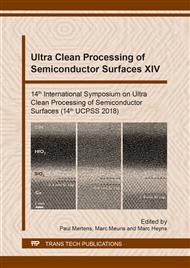p.39
p.43
p.48
p.52
p.59
p.64
p.73
p.77
p.83
Removal of CrN Contamination from EUV Mask Backside Using Dry Cleaning
Abstract:
For EUV lithography, a reflective mask is essential because of use of the strong energy, wavelength of 13.5 nm. The EUV mask consists of multi-layered, multi-material structure and is susceptible to various contaminants. Since EUV lithography process should be used in a high vacuum environment, an electrostatic chuck (ESC) is used to fix or hold the EUV mask using electrostatic force. In general, in order to use ESC chuck, it needs a thin conductive layer (CrN layer) on the backside. However, the contact points of the electrostatic pin chuck can make exfoliation of conductive CrN layer producing CrN particles. If these particles are present on the backside of the mask, CD or DOF may be affected during EUV exposure. The 1 μm particle can leads to a gap radius of 42mm [4]. Moreover, these backside particles may travel to the front side. Therefore, backside cleaning should be performed to remove particles from the mask backside surface.
Info:
Periodical:
Pages:
59-63
Citation:
Online since:
August 2018
Authors:
Price:
Сopyright:
© 2018 Trans Tech Publications Ltd. All Rights Reserved
Share:
Citation:


